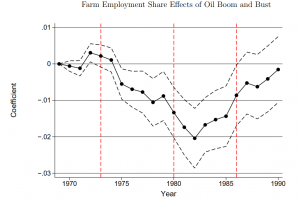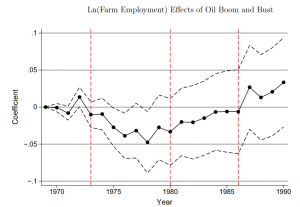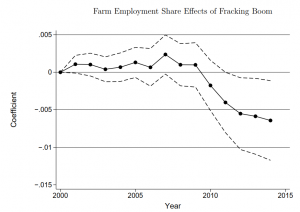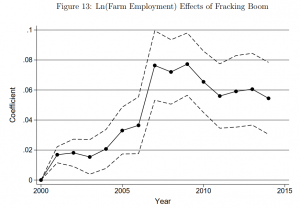There is a large literature in Economics on a phenomenon called the “Resource Curse”: the observation that countries or regions abundant in natural resources tend to experience slower economic growth. Whether resources actually cause slower growth is somewhat contested, and at a minimum it seems to depend on the quality of the country’s governance, among other factors. But one of the most studied possible causes of a resource curse is called “Dutch Disease”, a theory of how a natural resource boom could harm other sectors that are reliant on exports (it is so named after the decline in manufacturing that took place in the Netherlands following a major natural gas boom). Under this theory a natural resource boom pulls away labor and capital that would otherwise go into exportable sectors, and also raises the real exchange rate, which effectively raises the price of exported goods for other countries and making them less competitive.
Empirical studies on how natural resource booms impact exportable goods are somewhat mixed. In America natural resource booms seem to have actually benefited the local manufacturing sector. This is because in reality manufactured goods are not only exported; many are consumed locally. And a resource boom draws in a lot of workers and income that can be spent on locally produced goods.
Most of the Dutch Disease literature is focused on manufacturing, but there is surprisingly little research on how natural resource booms impact the local agricultural sector, which, like manufacturing, is both exported and domestically consumed. I was curious about this question and have written a brief working paper exploring this question.
I examine both long and short-run effects on oil booms in the United States. I look at both manufacturing and agricultural outcomes, but here I will focus on agriculture. To analyze long-run effects, I identify counties containing any “giant” oil field (containing at least 100 million barrels upon discovery). I then run a simple statistical analysis on whether these counties have more or less farm income and employment as of the year 2000 (controlling for farming activity in 1890 and other factors, but no need to get into the details here). I find that oil abundance is negatively associated with farming in the long-run, but the effect is quite small.
I then exploit two types of oil booms to analyze effects in real time: the massive oil price boom in the 1970s and the much more recent fracking boom. Here I test how farming employment in oil-abundant counties changes in response to these booms on a year-to-year basis, relative to changes in non-abundant counties. These results are summarized in the graphs below, which show effect sizes by year (the dotted lines are confidence intervals, which aren’t important for the purposes of this blog!). There is a clear downward trend in farming employment and employment share when oil was booming in the 1970s, which then recovers when prices tank in the 1980s. This indicates that oil booms were indeed harming the agricultural sector, at least in the short run.


The next graphs show similar analysis for how farming employment evolved in shale-rich counties relative to non-shale-rich counties. These results are somewhat more ambiguous – farming employment increases somewhat, but the share of employment decreases, reflecting the surge in employment in the fracking sector. Interestingly, farm earnings seems to decrease despite the rise in employment (graph not shown).


This is very early analysis, but the overall effects of oil booms on agriculture seem to be somewhat mixed. It is important to note that these are just average effects over the whole country. There are likely certain factors that determine when oil booms might have a more negative effect on agriculture. For example, many farmers in fracking areas ceased production and leased their land to fracking companies and collected royalties. But different states have different rules for leasing land that likely make this practice more common in certain areas. If any readers have other ideas or insights, feel free to let me know!

